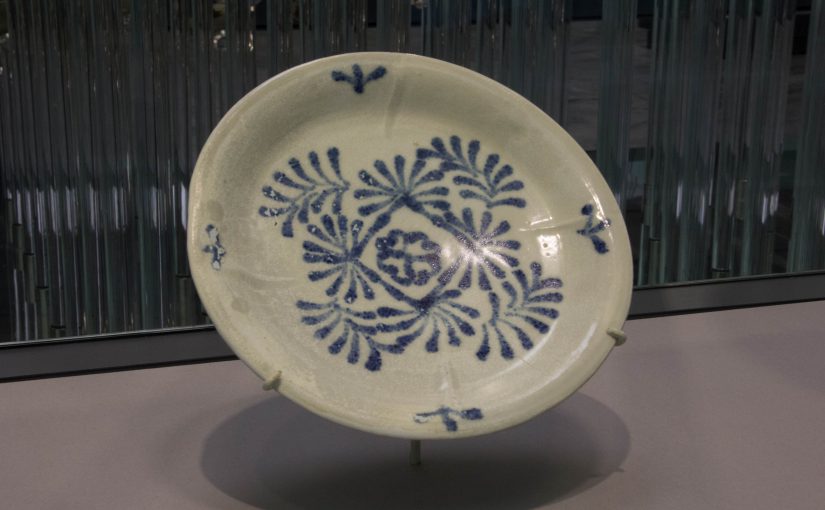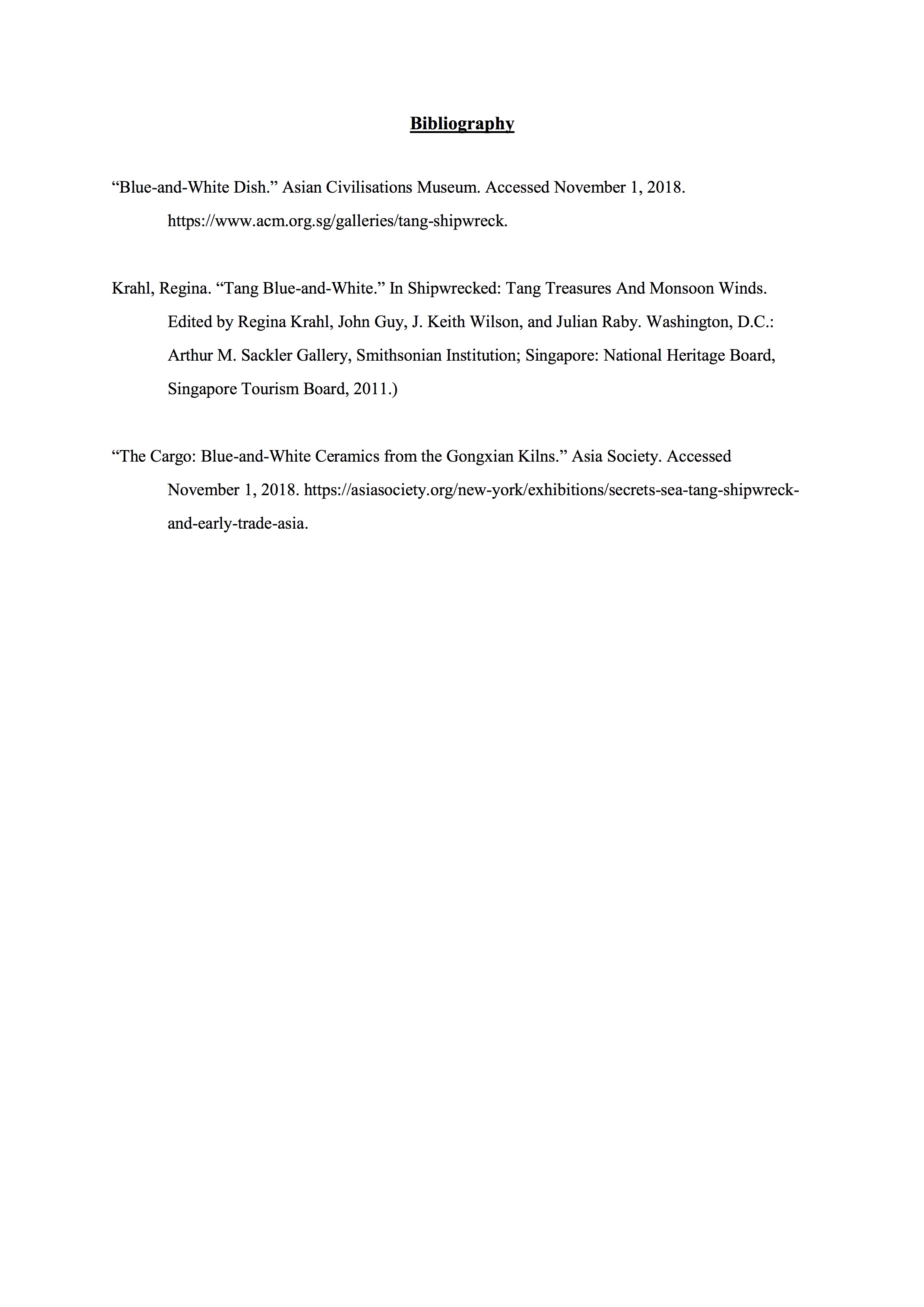Attached is the contextual analysis for the 9th CE Tang blue-and-white stoneware.
*UPDATED FOR EASIER READING*
Contextual Analysis
This blue-and-white ware was made in China, probably Gongxian kilns, ca 830s
Stoneware, diameter 23 cm
9th Century Potters in both China and West Asia contributed to the ninth-century creation of the earliest known blue-and-white ceramics. It is a combination of China’s superior ceramics technology with the unique cobalt blue glaze of Iran.
Initially, Near Eastern traders of China shipped white stonewares and porcelain to West Asia where they attempted to copy them. They attempted to cover their earthenwares with a white tin glaze but did not achieve the same quality as the original. However, it is through this that they began decorating their new white wares with their cobalt blue glaze. Again, the means by which they were applying the blue glaze resulted in a less than stellar final product.
The earliest known blue-and-white stonewares were created as a result of the interaction between China and West Asia in the 9th century. The blue-and-white ceramics of the Belitung Shipwreck were painted with a blue glaze. The practice of painting with cobalt blue seems to have started with Basran potters. Despite being made in China, they used cobalt blue glaze that had likely been mined in Iran, which shows the level of globalisation already happening during the 9th century.
The Gongxian potters painted a lozenge pattern with flowers in the centre of it. This design appears on a variety of objects bound for the Abbasid, where the design originally developed. The lozenge motif is a design favoured in the Middle East, which again, shows the connection between China and the Middle East. It also possibly means that the Chinese were trying to create these plates for the Middle Eastern market which was the Abbasid Empire that includes modern-day Iran, Iraq, and the surrounding regions.
The blue-and-white dishes discovered with the ship are the first and earliest complete Chinese blue-and-white ceramics known to exist to date. This gives us insight into the birth of blue-and-white Chinese ceramics and its subsequent popularity among in the world – inspiring others to try to copy and eventually succeeding in achieving a similar quality.
While the blue-and-white stonewares of Gongxian kilns have been claimed to be the earliest examples of the design, it is only in the Jingdezhen kilns where blue-and-white porcelains really took off which then inspired the imitations and rush to create others of similar quality.
Bibliography
“Blue-and-White Dish.” Asian Civilisations Museum. Accessed November 1, 2018. https://www.acm.org.sg/galleries/tang-shipwreck.
Krahl, Regina. “Tang Blue-and-White.” In Shipwrecked: Tang Treasures And Monsoon Winds. Edited by Regina Krahl, John Guy, J. Keith Wilson, and Julian Raby. Washington, D.C.: Arthur M. Sackler Gallery, Smithsonian Institution; Singapore: National Heritage Board, Singapore Tourism Board, 2011.)
“The Cargo: Blue-and-White Ceramics from the Gongxian Kilns.” Asia Society. Accessed November 1, 2018. https://asiasociety.org/new-york/exhibitions/secrets-sea-tang-shipwreck-and-early-trade-asia.
Zhu, Feng and Jie Shao. “The Origin Of Blue-And-White And The Birth Of
Symbols.” Asian Social Science 5, no. 5 (2009): 77-81. Accessed April 1,
2017. http://www.ccsenet.org/journal/index.php/ass/article/viewFile/1712/1605.


Normal
0
false
false
false
EN-US
JA
X-NONE
/* Style Definitions */
table.MsoNormalTable
{mso-style-name:”Table Normal”;
mso-tstyle-rowband-size:0;
mso-tstyle-colband-size:0;
mso-style-noshow:yes;
mso-style-priority:99;
mso-style-parent:””;
mso-padding-alt:0cm 5.4pt 0cm 5.4pt;
mso-para-margin:0cm;
mso-para-margin-bottom:.0001pt;
mso-pagination:widow-orphan;
font-size:12.0pt;
font-family:Cambria;
mso-ascii-font-family:Cambria;
mso-ascii-theme-font:minor-latin;
mso-hansi-font-family:Cambria;
mso-hansi-theme-font:minor-latin;
mso-fareast-language:EN-US;}
You have provided a good contextual analysis that attends to production, materials, and patrons. I also appreciate the last paragraph as it shows how complex the lineage of blue and white is and how your object connects to the rest of the objects in your gallery guide.
But, what does the lozenge motif mean? Where else was it used? What could have been the function of this plate based on its shape, colors, and motif?
Your bibliography needs 4 varied sources.
Also, it’s really hard to read this post…
The development of science and technology by Muslims caused the rise in popularity of geometric shapes in ornamentation. 9th Century Middle East sees the earliest attempts at applying geometrical ornaments on vegetal or floral motifs in Islamic architecture. This application of geometry on floral ornaments was an attempt at transforming the naturalism of early Islamic ornaments to something more abstract. Through geometric art, spirituality is connected to art and science – geometry conveys the idea of perfection and beauty, which is connected to the idea of god. Hence the lozenge motif is a representation of spirituality.
The lozenge motif is also found in 9th Century Abbasid empire architecture along with vegetal and floral motifs.
Considering that this was only one of a few plates recovered from the shipwreck, it is probable that this plate was not produced in huge numbers which means that it was not easy to produce hence adding a level of rarity and novelty to the artifact. The plate is simple in shape, with a special focus on its blue-glaze decoration, which happens to be of a Middle Eastern design. In this scenario, it would likely be for display or ceremonial purposes. Because this was one of the first few instances of blue-and-white wares being produced by China, it could also be a gift from China to the Middle Eastern royalty as a diplomatic gesture.
Bibliography
Abdullahi, Yahya and Mohamed Rashid Bin Embi. Evolution of Islamic geometric patterns. Frontiers of Architectural Research
2, No. 2 (2013): 243-251. Accessed November 19, 2018. https://www-sciencedirect-com.ezlibproxy1.ntu.edu.sg/science/article/pii/S2095263513000216.
Saeed, Khawaja M. Islamic Art and Its Spiritual Message. International Journal of Humanities and Social Science 1, No.2 (2011): 227-234. Accessed November 19, 2018. http://www.ijhssnet.com/journals/Vol._1_No._2;_February_2011/30.pdf.
Thanks for addressing the development of the lozenge!